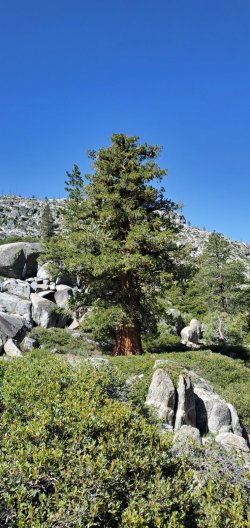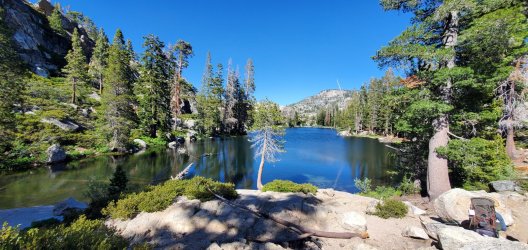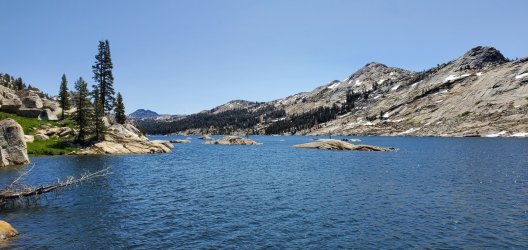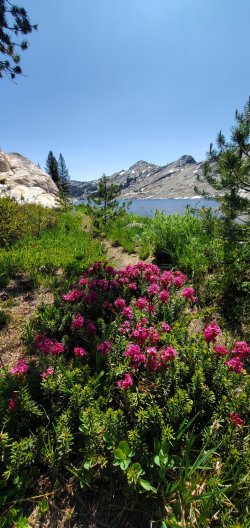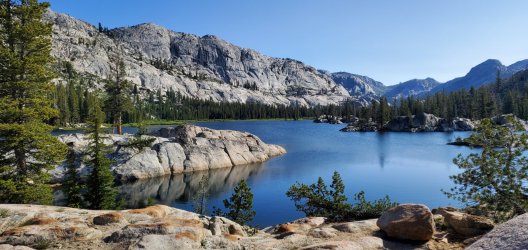DoYouEvenHikeBro
New Member
- Joined
- Jul 9, 2025
- Messages
- 1
Overview
I did a 4-day backpacking trip in Emigrant Wilderness a few weeks ago.
The area is located in Stanislaus National Forest, immediately north of the Yosemite National Park border.
The environment looks a lot like Yosemite, with granite cliffs, pine forests, streams, and stunning alpine lakes.
Unlike Yosemite though, there are no permit quotas or fees needed for this area! Music to my ears. You just need to sign up at the ranger station with a rough plan of where you're going in case you go missing.
Campfires
Also exciting was that backcountry fires were actually allowed here. Every other time I've hiked in California, fire restrictions have meant fires were only allowed in metal pits in developed campgrounds, so this was a first. There was a restriction above 9000ft, but most of the lakes you'll camp at are below this altitude. Also said no fires within a mile of Emigrant lake, but that wasn't a problem for us since our deepest camp was at Buck lake, which is more than 1mi away.
Getting There
Hiking began (and ended) at Crabtree Trailhead. It's searchable on Google Maps, but here are the coordinates (which you can paste directly into Google Maps, and most other map software): 38.1785901416022, -119.90682571350129
The road to get to the trailhead is almost entirely paved, with a couple spots having gravel bits, but it was no problem to drive over it in a VW Golf sedan.
Recommend stopping for gas and any last minute supplies in Sonora, as it has more options than the closest town to the trailhead, Pinecrest.
The Camps
Night 1: We started on the trailhead pretty late unfortunately, so our initial goal was to camp at Piute lake or Gem lake, but we were definitely not going to make that distance before sundown. Instead, we took the offshoot trail towards Bear Lake and camped there. The area was lovely, there was a granite outcropping with lots of spots for tents overlooking the water. Went swimming in the lake too, water was excellent.
Night 2: Woke up early, and made a big push all the way to upper Buck lake. On the way, stopped for a brief snack break at Piute lake, and a longer lunch break at Gem lake, where we also went swimming. Once we arrived at upper Buck lake, we started looking for camps, and became concerned at the lack thereof. Finally, found one area with room for tents at a granite outcropping overlooking the lake. Once you come down from the main trail and hit the lake, take a right along the lake roughly along the water and you'll find it. We ended up having the lake to ourselves, and it was quite spectacular.
Night 3: Woke up, packed our tents, and took smaller day packs on a out-and-back hike up to Emigrant lake. Definitely worth seeing, but we did not swim here as it was still too cold. Then back down, and went down the same way we came, passing Deer lake, Jewelry lake, Gem lake, and finally stopped to camp again at Piute lake. The area around the lake is somewhat overgrown, so wanted to avoid it due to mosquitos. We went slightly west of the lake and found another granite outcropping suitable for tents.
Day 4: Woke up early, and headed down the same trail until we got to a connector to the lower trail, and decided to take it since it would mean less elevation gain on the way back (the last area has a lot of up-and-down sections that add up). Connector trail was a little overgrown with fallen trees, but navigable. The kept going and passed Grouse lake, and eventually made it back to the trailhead.
Mosquitos
From my reading online, early to mid June can be a brutal time for mosquitos in these areas. As the snow melts, and creates little puddles of water everywhere, mosquitos begin to breed like crazy. Given this, I brought a head net and some bug spray, just in case, and had a tent with a net liner as well. It turned out though that I did not use my head net or spray, and that was for several reasons:
1. Try not to stop too much while hiking, especially in shady, overgrown areas with bushes and/or stagnant water. Moving is the best way to stop bites.
2. Wear thicker clothing on the areas on your body which are not in motion. Legs and hands move quite a bit as you swing them back-and-forth, but for example I got bit several times around the back of my shoulders near my backpack strap. There, the strap pressed my loose shirt against my skin, allowing the mosquitos to just bite right through. As soon as I switched to a thicker shirt, 0 bites. Alternatively, two layers of very loose shirts is also a good idea for breathability.
3. Pick your campsite wisely. If you are close to the water, and in areas with shrubs, shade, thicket of trees, then mosquitos will be plentiful. If you choose more open areas, with lots of granite around, you may see a few at peak hours before sundown, but you won't be thinking about it and can enjoy yourself.
4. You don't control fully control this, but a light breeze is ideal. Picking areas that are a bit more exposed allows a breeze to come through. Temperature is the same way, cooler nights mean less mosquitos, especially if it gets below freezing.
5. Campfires. I'm not actually sure how much this helps, but we did have one each night, and there weren't many mosquitos. I think the reasons above are more impactful either way.
I did a 4-day backpacking trip in Emigrant Wilderness a few weeks ago.
The area is located in Stanislaus National Forest, immediately north of the Yosemite National Park border.
The environment looks a lot like Yosemite, with granite cliffs, pine forests, streams, and stunning alpine lakes.
Unlike Yosemite though, there are no permit quotas or fees needed for this area! Music to my ears. You just need to sign up at the ranger station with a rough plan of where you're going in case you go missing.
Campfires
Also exciting was that backcountry fires were actually allowed here. Every other time I've hiked in California, fire restrictions have meant fires were only allowed in metal pits in developed campgrounds, so this was a first. There was a restriction above 9000ft, but most of the lakes you'll camp at are below this altitude. Also said no fires within a mile of Emigrant lake, but that wasn't a problem for us since our deepest camp was at Buck lake, which is more than 1mi away.
Getting There
Hiking began (and ended) at Crabtree Trailhead. It's searchable on Google Maps, but here are the coordinates (which you can paste directly into Google Maps, and most other map software): 38.1785901416022, -119.90682571350129
The road to get to the trailhead is almost entirely paved, with a couple spots having gravel bits, but it was no problem to drive over it in a VW Golf sedan.
Recommend stopping for gas and any last minute supplies in Sonora, as it has more options than the closest town to the trailhead, Pinecrest.
The Camps
Night 1: We started on the trailhead pretty late unfortunately, so our initial goal was to camp at Piute lake or Gem lake, but we were definitely not going to make that distance before sundown. Instead, we took the offshoot trail towards Bear Lake and camped there. The area was lovely, there was a granite outcropping with lots of spots for tents overlooking the water. Went swimming in the lake too, water was excellent.
Night 2: Woke up early, and made a big push all the way to upper Buck lake. On the way, stopped for a brief snack break at Piute lake, and a longer lunch break at Gem lake, where we also went swimming. Once we arrived at upper Buck lake, we started looking for camps, and became concerned at the lack thereof. Finally, found one area with room for tents at a granite outcropping overlooking the lake. Once you come down from the main trail and hit the lake, take a right along the lake roughly along the water and you'll find it. We ended up having the lake to ourselves, and it was quite spectacular.
Night 3: Woke up, packed our tents, and took smaller day packs on a out-and-back hike up to Emigrant lake. Definitely worth seeing, but we did not swim here as it was still too cold. Then back down, and went down the same way we came, passing Deer lake, Jewelry lake, Gem lake, and finally stopped to camp again at Piute lake. The area around the lake is somewhat overgrown, so wanted to avoid it due to mosquitos. We went slightly west of the lake and found another granite outcropping suitable for tents.
Day 4: Woke up early, and headed down the same trail until we got to a connector to the lower trail, and decided to take it since it would mean less elevation gain on the way back (the last area has a lot of up-and-down sections that add up). Connector trail was a little overgrown with fallen trees, but navigable. The kept going and passed Grouse lake, and eventually made it back to the trailhead.
Mosquitos
From my reading online, early to mid June can be a brutal time for mosquitos in these areas. As the snow melts, and creates little puddles of water everywhere, mosquitos begin to breed like crazy. Given this, I brought a head net and some bug spray, just in case, and had a tent with a net liner as well. It turned out though that I did not use my head net or spray, and that was for several reasons:
1. Try not to stop too much while hiking, especially in shady, overgrown areas with bushes and/or stagnant water. Moving is the best way to stop bites.
2. Wear thicker clothing on the areas on your body which are not in motion. Legs and hands move quite a bit as you swing them back-and-forth, but for example I got bit several times around the back of my shoulders near my backpack strap. There, the strap pressed my loose shirt against my skin, allowing the mosquitos to just bite right through. As soon as I switched to a thicker shirt, 0 bites. Alternatively, two layers of very loose shirts is also a good idea for breathability.
3. Pick your campsite wisely. If you are close to the water, and in areas with shrubs, shade, thicket of trees, then mosquitos will be plentiful. If you choose more open areas, with lots of granite around, you may see a few at peak hours before sundown, but you won't be thinking about it and can enjoy yourself.
4. You don't control fully control this, but a light breeze is ideal. Picking areas that are a bit more exposed allows a breeze to come through. Temperature is the same way, cooler nights mean less mosquitos, especially if it gets below freezing.
5. Campfires. I'm not actually sure how much this helps, but we did have one each night, and there weren't many mosquitos. I think the reasons above are more impactful either way.

